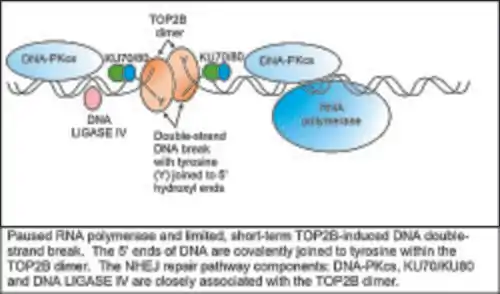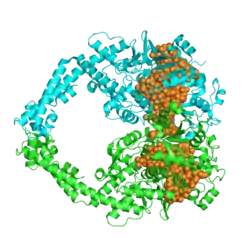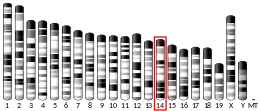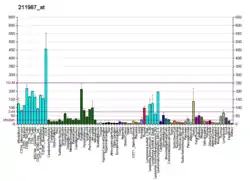TOP2B
DNA topoisomerase 2-beta is an enzyme that in humans is encoded by the TOP2B gene.[5][6]
Function
This gene encodes a DNA topoisomerase, an enzyme that controls and alters the topologic states of DNA during transcription. This nuclear enzyme is involved in processes such as chromosome condensation, chromatid separation, and the relief of torsional stress that occurs during DNA transcription and replication. It catalyzes the transient breaking and rejoining of two strands of duplex DNA which allows the strands to pass through one another, thus altering the topology of DNA. Two forms of this enzyme exist as likely products of a gene duplication event. The gene encoding this form, beta, is localized to chromosome 3 and the alpha form is localized to chromosome 17. The gene encoding this enzyme functions as the target for several anticancer agents, for example mitoxantrone, and a variety of mutations in this gene have been associated with the development of drug resistance. Reduced activity of this enzyme may also play a role in ataxia-telangiectasia. Alternative splicing of this gene results in two transcript variants; however, the second variant has not yet been fully described.[7]
Neuronal activity
During a new learning experience, a set of genes is rapidly expressed in the brain. This induced gene expression is considered to be essential for processing the information being learned. Such genes are referred to as immediate early genes (IEGs). TOP2B activity is essential for the expression of IEGs in a type of learning experience in mice termed associative fear memory.[8] Such a learning experience appears to rapidly trigger TOP2B to induce double-strand breaks in the promoter DNA of IEG genes that function in neuroplasticity. Repair of these induced breaks is associated with DNA demethylation of IEG gene promoters allowing immediate expression of these IEG genes.[8]
Activation of more than 600 regulatory sequences in promoters and 800 regulatory sequences in enhancers, in many cell types, appears to depend on short-term double-strand breaks initiated by TOP2B.[9][10] The induction of particular double-strand breaks are specific with respect to their inducing signal. When neurons are activated in vitro, just 22 of TOP2B-induced double-strand breaks occur in their genomes, largely at immediate early genes.[11]

The induction of short-term double-strand breaks by TOP2B occurs in association with at least four enzymes of the non-homologous end joining (NHEJ) DNA repair pathway (DNA-PKcs, KU70, KU80 and DNA LIGASE IV) (see Figure). These enzymes repair the double-strand breaks within about 15 minutes to two hours.[11][12] The double-strand breaks in the promoter are thus associated with TOP2B and at least these four repair enzymes. These proteins are present simultaneously on a single promoter nucleosome (there are about 147 nucleotides in the DNA sequence wrapped around a single nucleosome) located near the transcription start site of their target gene.[12]
The double-strand break introduced by TOP2B apparently frees a part of the promoter at an RNA polymerase-bound transcription start site to physically move to its associated enhancer (see regulatory sequence). This allows the enhancer, with its bound transcription factors and mediator proteins, to directly interact with the RNA polymerase paused at the transcription start site to start transcription.[11][13]

Contextual fear conditioning in the mouse causes the mouse to have a long-term memory and fear of the location in which it occurred. This conditioning causes hundreds of gene-associated DSBs in the medial prefrontal cortex (mPFC) and hippocampus that are important for learning and memory.[14]
Other TOP2B and DNA interactions
Interactions of TOP2B and DNA also regulate transcription of genes that are important for development. These include genes encoding axon guidance factors and cell adhesion molecules. Specifically, TOP2B is required for lamina-specific targeting of retinal ganglion cell axons and dendrites in the zebrafish.[15]
Interactions
TOP2B has been shown to interact with:
In other species
In Drosophila Hadlaczky et al 1988 found DNA topoisomerase II β did not correlate with cell proliferation - while α did.[22]
References
- GRCh38: Ensembl release 89: ENSG00000077097 - Ensembl, May 2017
- GRCm38: Ensembl release 89: ENSMUSG00000017485 - Ensembl, May 2017
- "Human PubMed Reference:". National Center for Biotechnology Information, U.S. National Library of Medicine.
- "Mouse PubMed Reference:". National Center for Biotechnology Information, U.S. National Library of Medicine.
- Tan KB, Dorman TE, Falls KM, Chung TD, Mirabelli CK, Crooke ST, Mao J (January 1992). "Topoisomerase II alpha and topoisomerase II beta genes: characterization and mapping to human chromosomes 17 and 3, respectively". Cancer Research. 52 (1): 231–234. PMID 1309226.
- Jenkins JR, Ayton P, Jones T, Davies SL, Simmons DL, Harris AL, et al. (November 1992). "Isolation of cDNA clones encoding the beta isozyme of human DNA topoisomerase II and localisation of the gene to chromosome 3p24". Nucleic Acids Research. 20 (21): 5587–5592. doi:10.1093/nar/20.21.5587. PMC 334390. PMID 1333583.
- "Entrez Gene: TOP2B topoisomerase (DNA) II beta 180kDa".
- Li X, Marshall PR, Leighton LJ, Zajaczkowski EL, Wang Z, Madugalle SU, et al. (February 2019). "The DNA Repair-Associated Protein Gadd45γ Regulates the Temporal Coding of Immediate Early Gene Expression within the Prelimbic Prefrontal Cortex and Is Required for the Consolidation of Associative Fear Memory". The Journal of Neuroscience. 39 (6): 970–983. doi:10.1523/JNEUROSCI.2024-18.2018. PMC 6363930. PMID 30545945. (Erratum: PMID 30545945)
- Dellino GI, Palluzzi F, Chiariello AM, Piccioni R, Bianco S, Furia L, et al. (June 2019). "Release of paused RNA polymerase II at specific loci favors DNA double-strand-break formation and promotes cancer translocations". Nature Genetics. 51 (6): 1011–1023. doi:10.1038/s41588-019-0421-z. PMID 31110352. S2CID 159041612.
- Singh S, Szlachta K, Manukyan A, Raimer HM, Dinda M, Bekiranov S, Wang YH (March 2020). "Pausing sites of RNA polymerase II on actively transcribed genes are enriched in DNA double-stranded breaks". The Journal of Biological Chemistry. 295 (12): 3990–4000. doi:10.1074/jbc.RA119.011665. PMC 7086017. PMID 32029477.
- Madabhushi R, Gao F, Pfenning AR, Pan L, Yamakawa S, Seo J, et al. (June 2015). "Activity-Induced DNA Breaks Govern the Expression of Neuronal Early-Response Genes". Cell. 161 (7): 1592–1605. doi:10.1016/j.cell.2015.05.032. PMC 4886855. PMID 26052046.
- Ju BG, Lunyak VV, Perissi V, Garcia-Bassets I, Rose DW, Glass CK, Rosenfeld MG (June 2006). "A topoisomerase IIbeta-mediated dsDNA break required for regulated transcription". Science. 312 (5781): 1798–1802. Bibcode:2006Sci...312.1798J. doi:10.1126/science.1127196. PMID 16794079. S2CID 206508330.
- Allen BL, Taatjes DJ (March 2015). "The Mediator complex: a central integrator of transcription". Nature Reviews. Molecular Cell Biology. 16 (3): 155–166. doi:10.1038/nrm3951. PMC 4963239. PMID 25693131.
- Stott RT, Kritsky O, Tsai LH (2021). "Profiling DNA break sites and transcriptional changes in response to contextual fear learning". PLOS ONE. 16 (7): e0249691. Bibcode:2021PLoSO..1649691S. doi:10.1371/journal.pone.0249691. PMC 8248687. PMID 34197463.
- Nevin LM, Xiao T, Staub W, Baier H (June 2011). "Topoisomerase IIbeta is required for lamina-specific targeting of retinal ganglion cell axons and dendrites". Development. 138 (12): 2457–2465. doi:10.1242/dev.060335. PMC 3100707. PMID 21610027.
- Kitagawa H, Fujiki R, Yoshimura K, Mezaki Y, Uematsu Y, Matsui D, et al. (June 2003). "The chromatin-remodeling complex WINAC targets a nuclear receptor to promoters and is impaired in Williams syndrome". Cell. 113 (7): 905–917. doi:10.1016/s0092-8674(03)00436-7. PMID 12837248.
- Tsai SC, Valkov N, Yang WM, Gump J, Sullivan D, Seto E (November 2000). "Histone deacetylase interacts directly with DNA topoisomerase II". Nature Genetics. 26 (3): 349–353. doi:10.1038/81671. PMID 11062478. S2CID 19301396.
- Johnson CA, Padget K, Austin CA, Turner BM (February 2001). "Deacetylase activity associates with topoisomerase II and is necessary for etoposide-induced apoptosis". The Journal of Biological Chemistry. 276 (7): 4539–4542. doi:10.1074/jbc.C000824200. PMID 11136718.
- Cowell IG, Okorokov AL, Cutts SA, Padget K, Bell M, Milner J, Austin CA (February 2000). "Human topoisomerase IIalpha and IIbeta interact with the C-terminal region of p53". Experimental Cell Research. 255 (1): 86–94. doi:10.1006/excr.1999.4772. PMID 10666337.
- Mao Y, Desai SD, Liu LF (August 2000). "SUMO-1 conjugation to human DNA topoisomerase II isozymes". The Journal of Biological Chemistry. 275 (34): 26066–26073. doi:10.1074/jbc.M001831200. PMID 10862613.
- Nakano H, Yamazaki T, Miyatake S, Nozaki N, Kikuchi A, Saito T (March 1996). "Specific interaction of topoisomerase II beta and the CD3 epsilon chain of the T cell receptor complex". The Journal of Biological Chemistry. 271 (11): 6483–6489. doi:10.1074/jbc.271.11.6483. PMID 8626450.
- Wang JC (1996). "DNA topoisomerases". Annual Review of Biochemistry. Annual Reviews. 65 (1): 635–692. doi:10.1146/annurev.bi.65.070196.003223. PMID 8811192.
Further reading
- Champoux JJ (2002). "DNA topoisomerases: structure, function, and mechanism". Annual Review of Biochemistry. 70: 369–413. doi:10.1146/annurev.biochem.70.1.369. PMID 11395412.
- Austin CA, Fisher LM (June 1990). "Isolation and characterization of a human cDNA clone encoding a novel DNA topoisomerase II homologue from HeLa cells". FEBS Letters. 266 (1–2): 115–117. doi:10.1016/0014-5793(90)81520-X. PMID 2163884. S2CID 46581515.
- Chung TD, Drake FH, Tan KB, Per SR, Crooke ST, Mirabelli CK (December 1989). "Characterization and immunological identification of cDNA clones encoding two human DNA topoisomerase II isozymes". Proceedings of the National Academy of Sciences of the United States of America. 86 (23): 9431–9435. Bibcode:1989PNAS...86.9431C. doi:10.1073/pnas.86.23.9431. PMC 298510. PMID 2556712.
- Austin CA, Sng JH, Patel S, Fisher LM (March 1993). "Novel HeLa topoisomerase II is the II beta isoform: complete coding sequence and homology with other type II topoisomerases". Biochimica et Biophysica Acta (BBA) - Gene Structure and Expression. 1172 (3): 283–291. doi:10.1016/0167-4781(93)90215-Y. PMID 8383537.
- Davies SL, Jenkins JR, Hickson ID (August 1993). "Human cells express two differentially spliced forms of topoisomerase II beta mRNA". Nucleic Acids Research. 21 (16): 3719–3723. doi:10.1093/nar/21.16.3719. PMC 309874. PMID 8396237.
- Nakano H, Yamazaki T, Miyatake S, Nozaki N, Kikuchi A, Saito T (March 1996). "Specific interaction of topoisomerase II beta and the CD3 epsilon chain of the T cell receptor complex". The Journal of Biological Chemistry. 271 (11): 6483–6489. doi:10.1074/jbc.271.11.6483. PMID 8626450.
- Biersack H, Jensen S, Gromova I, Nielsen IS, Westergaard O, Andersen AH (August 1996). "Active heterodimers are formed from human DNA topoisomerase II alpha and II beta isoforms". Proceedings of the National Academy of Sciences of the United States of America. 93 (16): 8288–8293. Bibcode:1996PNAS...93.8288B. doi:10.1073/pnas.93.16.8288. PMC 38663. PMID 8710863.
- Meyer KN, Kjeldsen E, Straub T, Knudsen BR, Hickson ID, Kikuchi A, et al. (February 1997). "Cell cycle-coupled relocation of types I and II topoisomerases and modulation of catalytic enzyme activities". The Journal of Cell Biology. 136 (4): 775–788. doi:10.1083/jcb.136.4.775. PMC 2132491. PMID 9049244.
- Fukunaga R, Hunter T (April 1997). "MNK1, a new MAP kinase-activated protein kinase, isolated by a novel expression screening method for identifying protein kinase substrates". The EMBO Journal. 16 (8): 1921–1933. doi:10.1093/emboj/16.8.1921. PMC 1169795. PMID 9155018.
- Ng SW, Liu Y, Schnipper LE (December 1997). "Cloning and characterization of the 5'-flanking sequence for the human DNA topoisomerase II beta gene". Gene. 203 (2): 113–119. doi:10.1016/S0378-1119(97)00500-3. PMID 9426241.
- Yamane K, Kawabata M, Tsuruo T (December 1997). "A DNA-topoisomerase-II-binding protein with eight repeating regions similar to DNA-repair enzymes and to a cell-cycle regulator". European Journal of Biochemistry. 250 (3): 794–799. doi:10.1111/j.1432-1033.1997.00794.x. PMID 9461304.
- Cowell IG, Willmore E, Chalton D, Marsh KL, Jazrawi E, Fisher LM, Austin CA (September 1998). "Nuclear distribution of human DNA topoisomerase IIbeta: a nuclear targeting signal resides in the 116-residue C-terminal tail". Experimental Cell Research. 243 (2): 232–240. doi:10.1006/excr.1998.4150. PMID 9743583.
- Lang AJ, Mirski SE, Cummings HJ, Yu Q, Gerlach JH, Cole SP (October 1998). "Structural organization of the human TOP2A and TOP2B genes". Gene. 221 (2): 255–266. doi:10.1016/S0378-1119(98)00468-5. PMID 9795238.
- Sng JH, Heaton VJ, Bell M, Maini P, Austin CA, Fisher LM (March 1999). "Molecular cloning and characterization of the human topoisomerase IIalpha and IIbeta genes: evidence for isoform evolution through gene duplication". Biochimica et Biophysica Acta. 1444 (3): 395–406. doi:10.1016/S0167-4781(99)00020-2. PMID 10095062.
- Bjergbaek L, Jensen S, Westergaard O, Andersen AH (September 1999). "Using a biochemical approach to identify the primary dimerization regions in human DNA topoisomerase IIalpha". The Journal of Biological Chemistry. 274 (37): 26529–26536. doi:10.1074/jbc.274.37.26529. PMID 10473615.
- Cowell IG, Okorokov AL, Cutts SA, Padget K, Bell M, Milner J, Austin CA (February 2000). "Human topoisomerase IIalpha and IIbeta interact with the C-terminal region of p53". Experimental Cell Research. 255 (1): 86–94. doi:10.1006/excr.1999.4772. PMID 10666337.
- Mao Y, Desai SD, Liu LF (August 2000). "SUMO-1 conjugation to human DNA topoisomerase II isozymes". The Journal of Biological Chemistry. 275 (34): 26066–26073. doi:10.1074/jbc.M001831200. PMID 10862613.
- Mirski SE, Voskoglou-Nomikos T, Young LC, Deeley RG, Campling BG, Gerlach JH, Cole SP (June 2000). "Simultaneous quantitation of topoisomerase II alpha and beta isoform mRNAs in lung tumor cells and normal and malignant lung tissue". Laboratory Investigation; A Journal of Technical Methods and Pathology. 80 (6): 787–795. doi:10.1038/labinvest.3780083. PMID 10879730.





